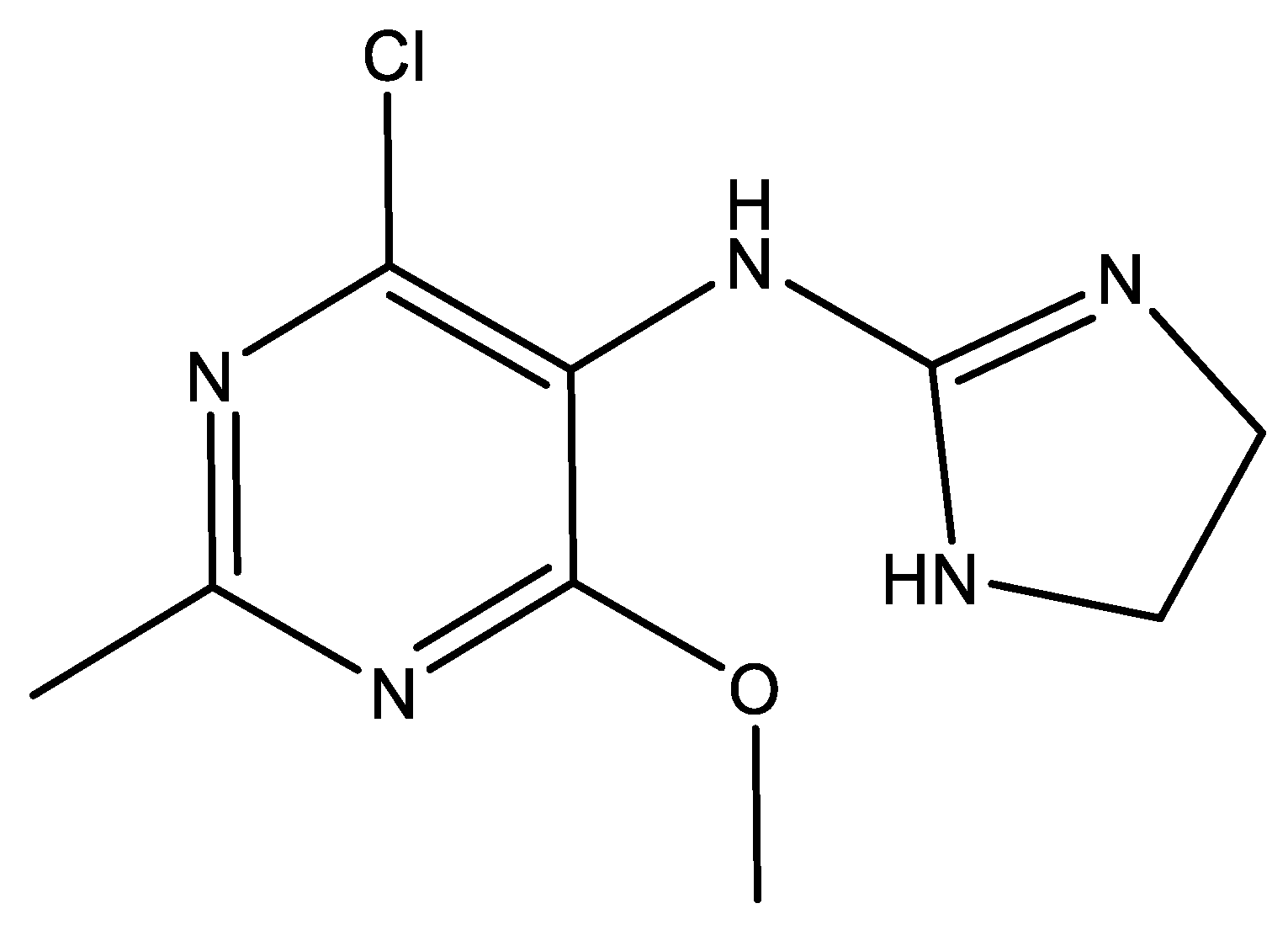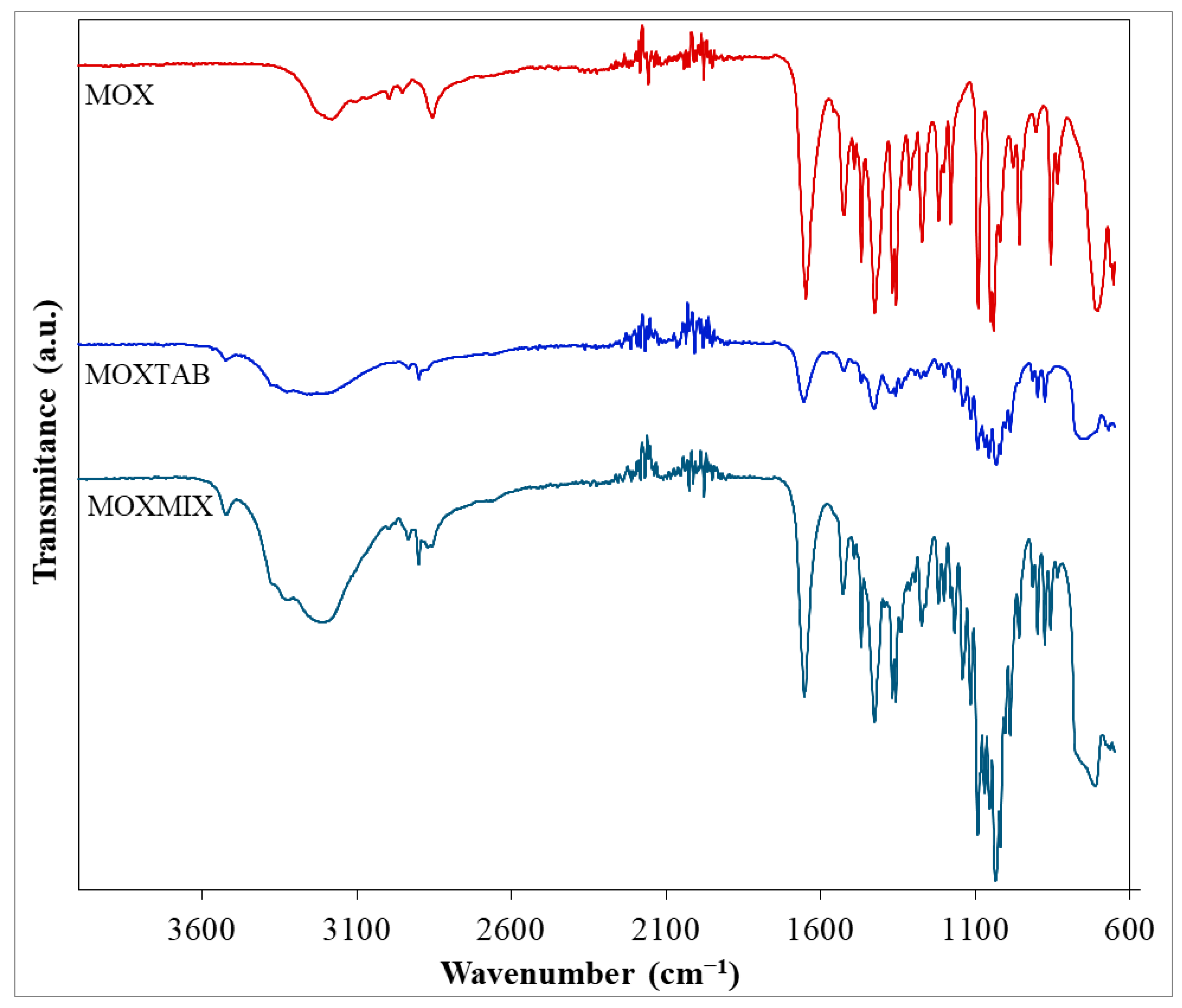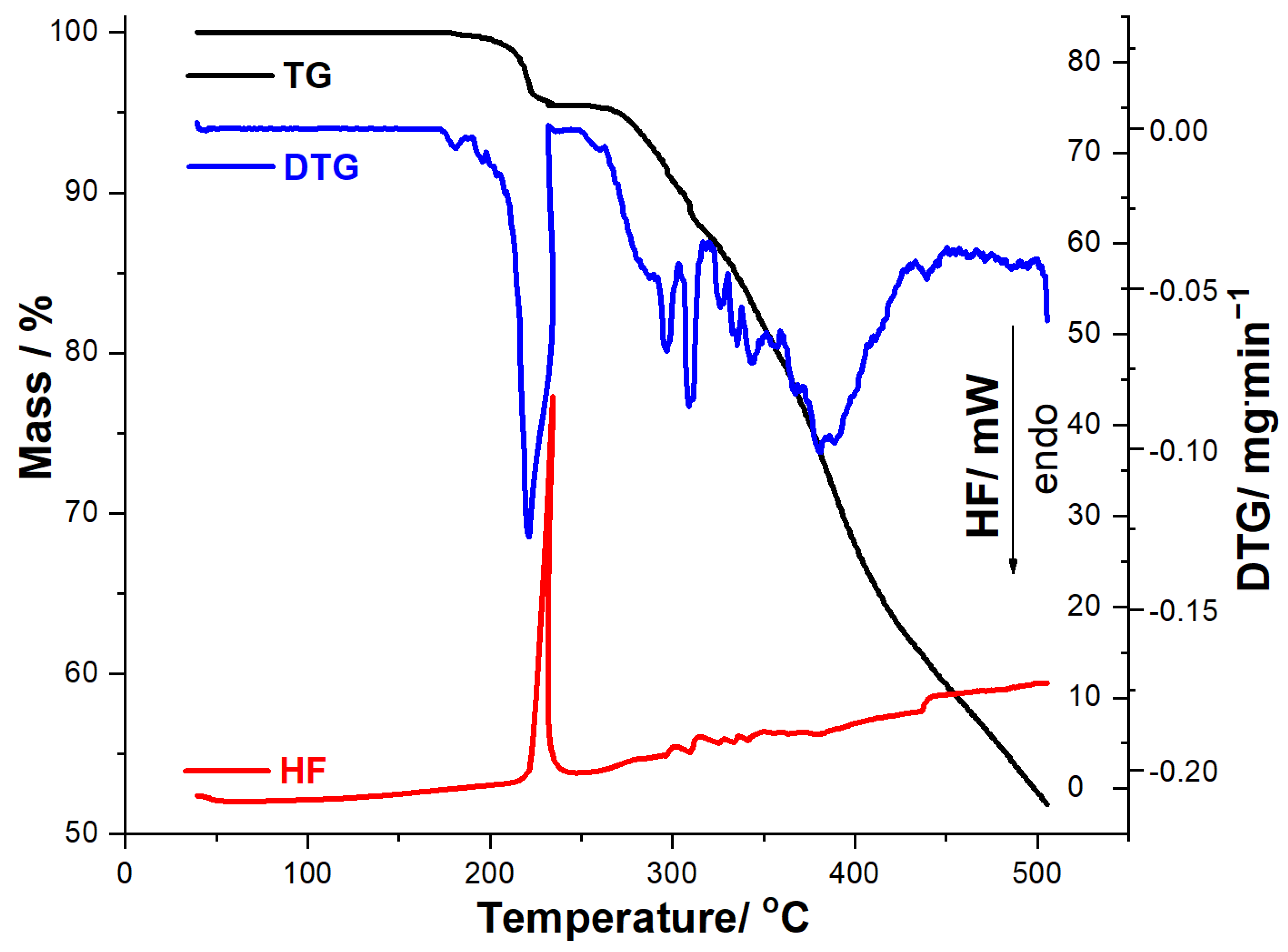Thermal Stability and Kinetics of Degradation of Moxonidine as Pure Ingredient vs. Pharmaceutical Formulation
Abstract
1. Introduction
2. Materials and Methods
2.1. Samples and Preparation
2.2. FTIR Investigations
2.3. Thermoanalytical Investigations
2.4. Kinetic Study
3. Results and Discussion
3.1. FTIR Investigations
3.2. Thermoanalytical Investigations
3.3. Kinetic Study
4. Conclusions
Supplementary Materials
Author Contributions
Funding
Data Availability Statement
Conflicts of Interest
References
- Gamboa, A.; Okamoto, L.E.; Shibao, C.A.; Biaggioni, I. Obesity-associated hypertension. In Primer on the Autonomic Nervous System; Biaggioni, I., Browning, K., Fink, G., Jordan, J., Low, P.A., Paton, J.F.R., Eds.; Academic Press: Cambridge, MA, USA, 2023; pp. 471–474. ISBN 978-0-323-85492-4. [Google Scholar]
- Karlafti, E.; Didangelos, T.; Benioudakis, E.; Kotzakioulafi, E.; Kaiafa, G.; Kotsis, V.; Ziakas, A.; Doumas, M.; Goulas, A.; Savopoulos, C. Effects of Moxonidine Administration on Serum Neuropeptide Y Levels in Hypertensive Individuals: A Prospective Observational Study. Endocrines 2022, 3, 43–52. [Google Scholar] [CrossRef]
- Karlafti, E.F.; Hatzitolios, A.I.; Karlaftis, A.F.; Baltatzi, M.S.; Koliakos, G.G.; Savopoulos, C.G. Effects of moxonidine on sympathetic nervous system activity: An update on metabolism, cardio, and other target-organ protection. J. Pharm. Bioallied Sci. 2013, 5, 253–256. [Google Scholar] [PubMed]
- Fenton, C.; Keating, G.M.; Lyseng-Williamson, K.A. Moxonidine: A review of its use in essential hypertension. Drugs 2006, 66, 477–496. [Google Scholar] [CrossRef] [PubMed]
- Abellán, J.; Leal, M.; Hernández-Menárguez, F.; García-Galbis, J.A.; Martínez-Pastor, A.; De Vinuesa, S.G.; Luño, J. Efficacy of moxonidine in the treatment of hypertension in obese, noncontrolled hypertensive patients. Kidney Int. Suppl. 2005, 67, S20–S24. [Google Scholar] [CrossRef] [PubMed]
- Wang, Y.; Nguyen, D.T.; Anesi, J.; Alramahi, A.; Witting, P.K.; Chai, Z.; Khan, A.W.; Kelly, J.; Denton, K.M.; Golledge, J. Moxonidine Increases Uptake of Oxidised Low-Density Lipoprotein in Cultured Vascular Smooth Muscle Cells and Inhibits Atherosclerosis in Apolipoprotein E-Deficient Mice. Int. J. Mol. Sci. 2023, 24, 3857. [Google Scholar] [CrossRef] [PubMed]
- Ernsberger, P.; Friedman, J.E.; Koletsky, R.J. The I1-imidazoline receptor. J. Hypertens. 1997, 15, S9–S23. [Google Scholar] [CrossRef]
- Sveinsdóttir, H.S.; Christensen, C.; Þorsteinsson, H.; Lavalou, P.; Parker, M.O.; Shkumatava, A.; Norton, W.H.J.; Andriambeloson, E.; Wagner, S.; Karlsson, K.Æ. Novel non-stimulants rescue hyperactive phenotype in an adgrl3.1 mutant zebrafish model of ADHD. Neuropsychopharmacology 2022. [Google Scholar] [CrossRef]
- Kramzer, L.F.; Hamorsky, K.T.; Graebing, P.W.; Wang, L.; Fuqua, J.L.; Matoba, N.; Lasnik, A.B.; Moncla, B.J.; Zhang, J.; Palmer, K.E.; et al. Preformulation Characterization of Griffithsin, a Biopharmaceutical Candidate for HIV Prevention. AAPS PharmSciTech 2021, 22, 83. [Google Scholar] [CrossRef]
- Asran, A.M.; Mohamed, M.A.; Khedr, G.E.; Eldin, G.M.G.; Yehia, A.M.; Mishra, R.K.; Allam, N.K. Investigation of the thermal stability of the antihypertensive drug nebivolol under different conditions: Experimental and computational analysis. J. Therm. Anal. Calorim. 2022, 147, 5779–5786. [Google Scholar] [CrossRef]
- Bengescu, C.; Ledeți, A.; Olariu, T.; Cîrcioban, D.; Muntean, C.; Vlase, G.; Vlase, T.; Tomoroga, C.; Dragomirescu, A.O.; Dascălu, D.; et al. Instrumental investigations of promestriene: First report regarding the solid-state characterization and compatibility with pharmaceutical excipients. J. Therm. Anal. Calorim. 2023, 148, 4641–4649. [Google Scholar] [CrossRef]
- Ledeti, I.; Bolintineanu, S.; Vlase, G.; Circioban, D.; Ledeti, A.; Vlase, T.; Suta, L.M.; Caunii, A.; Murariu, M. Compatibility study between antiparkinsonian drug Levodopa and excipients by FTIR spectroscopy, X-ray diffraction and thermal analysis. J. Therm. Anal. Calorim. 2017, 130, 433–441. [Google Scholar] [CrossRef]
- Rojek, B.; Wesolowski, M. A combined differential scanning calorimetry and thermogravimetry approach for the effective assessment of drug substance-excipient compatibility. J. Therm. Anal. Calorim. 2023, 148, 845–858. [Google Scholar] [CrossRef]
- Li, X.; Liu, J.; Qiu, N. Cyclodextrin-Based Polymeric Drug Delivery Systems for Cancer Therapy. Polymers 2023, 15, 1400. [Google Scholar] [CrossRef] [PubMed]
- Kovacs, T.; Nagy, P.; Panyi, G.; Szente, L.; Varga, Z.; Zakany, F. Cyclodextrins: Only Pharmaceutical Excipients or Full-Fledged Drug Candidates? Pharmaceutics 2022, 14, 2559. [Google Scholar] [CrossRef] [PubMed]
- Soe, H.M.S.H.; Maw, P.D.; Loftsson, T.; Jansook, P. A Current Overview of Cyclodextrin-Based Nanocarriers for Enhanced Antifungal Delivery. Pharmaceuticals 2022, 15, 1447. [Google Scholar] [CrossRef]
- De Gaetano, F.; Cristiano, M.C.; Paolino, D.; Celesti, C.; Iannazzo, D.; Pistarà, V.; Iraci, N.; Ventura, C.A. Bicalutamide Anticancer Activity Enhancement by Formulation of Soluble Inclusion Complexes with Cyclodextrins. Biomolecules 2022, 12, 1716. [Google Scholar] [CrossRef]
- Dhondale, M.R.; Thakor, P.; Nambiar, A.G.; Singh, M.; Agrawal, A.K.; Shastri, N.R.; Kumar, D. Co-Crystallization Approach to Enhance the Stability of Moisture-Sensitive Drugs. Pharmaceutics 2023, 15, 189. [Google Scholar] [CrossRef]
- Xie, Y.; Yuan, P.; Heng, T.; Du, L.; An, Q.; Zhang, B.; Zhang, L.; Yang, D.; Du, G.; Lu, Y. Insight into the Formation of Cocrystal and Salt of Tenoxicam from the Isomer and Conformation. Pharmaceutics 2022, 14, 1968. [Google Scholar] [CrossRef]
- Birolo, R.; Bravetti, F.; Bordignon, S.; D’Abbrunzo, I.; Mazzeo, P.P.; Perissutti, B.; Bacchi, A.; Chierotti, M.R.; Gobetto, R. Overcoming the Drawbacks of Sulpiride by Means of New Crystal Forms. Pharmaceutics 2022, 14, 1754. [Google Scholar] [CrossRef]
- Islam, N.U.; Umar, M.N.; Khan, E.; Al-Joufi, F.A.; Abed, S.N.; Said, M.; Ullah, H.; Iftikhar, M.; Zahoor, M.; Khan, F.A. Levofloxacin Cocrystal/Salt with Phthalimide and Caffeic Acid as Promising Solid-State Approach to Improve Antimicrobial Efficiency. Antibiotics 2022, 11, 797. [Google Scholar] [CrossRef]
- Drozd, K.V.; Manin, A.N.; Boycov, D.E.; Perlovich, G.L. Simultaneous Improvement of Dissolution Behavior and Oral Bioavailability of Antifungal Miconazole via Cocrystal and Salt Formation. Pharmaceutics 2022, 14, 1107. [Google Scholar] [CrossRef] [PubMed]
- Mateescu, M.; Vlase, G.; Budiul, M.M.; Cernuşcă, B.D.; Vlase, T. Preliminary study for preparation and characterization of medicated jelly based on Ibuprofen or Ambroxol. J. Therm. Anal. Calorim. 2023, 148, 4601–4614. [Google Scholar] [CrossRef]
- Aslam, A.; Ashraf, M.U.; Barkat, K.; Mahmood, A.; Hussain, M.A.; Farid-ul-Haq, M.; Lashkar, M.O.; Gad, H.A. Fabrication of Stimuli-Responsive Quince/Mucin Co-Poly (Methacrylate) Hydrogel Matrices for the Controlled Delivery of Acyclovir Sodium: Design, Characterization and Toxicity Evaluation. Pharmaceutics 2023, 15, 650. [Google Scholar] [CrossRef]
- Vecchio, S.; Rodante, F.; Tomassetti, M. Thermal stability of disodium and calcium phosphomycin and the effects of the excipients evaluated by thermal analysis. J. Pharm. Biomed. Anal. 2001, 24, 1111–1123. [Google Scholar] [CrossRef] [PubMed]
- Chachorovska, M.; Petrushevski, G.; Stojanovska Pecova, M.; Ugarkovic, S.; Makreski, P. Thermal analysis assisted by spectra-structure studies of BCS class II active pharmaceutical ingredients: Ezetimibe and lercanidipine hydrochloride. The concept of preformulation. J. Therm. Anal. Calorim. 2022, 147, 8779–8790. [Google Scholar] [CrossRef]
- Ledeti, A.; Olariu, T.; Caunii, A.; Vlase, G.; Circioban, D.; Baul, B.; Ledeti, I.; Vlase, T.; Murariu, M. Evaluation of thermal stability and kinetic of degradation for levodopa in non-isothermal conditions. J. Therm. Anal. Calorim. 2018, 131, 1881–1888. [Google Scholar] [CrossRef]
- Kremer, I.; Tomić, T.; Katančić, Z.; Hrnjak-murgić, Z.; Erceg, M.; Ciprioti, S.V.; Schneider, D.R. Effect of Zeolite Catalyst on the Pyrolysis Kinetics of Multi-Layered Plastic Food Packaging. Symmetry 2022, 14, 1362. [Google Scholar] [CrossRef]
- Arcenegui-Troya, J.; Sánchez-Jiménez, P.E.; Perejón, A.; Pérez-Maqueda, L.A. Relevance of particle size distribution to kinetic analysis: The case of thermal dehydroxylation of kaolinite. Processes 2021, 9, 1852. [Google Scholar] [CrossRef]
- Rotaru, A.; Moanta, A.; Constantinescu, C.; Dumitru, M.; Manolea, H.O.; Andrei, A.; Dinescu, M. Thermokinetic study of CODA azoic liquid crystal and thin films deposition by matrix-assisted pulsed laser evaporation. J. Therm. Anal. Calorim. 2017, 128, 89–105. [Google Scholar] [CrossRef]
- Brown, M.E.; Maciejewski, M.; Vyazovkin, S.; Nomen, R.; Sempere, J.; Burnham, A.; Opfermann, J.; Strey, R.; Anderson, H.L.; Kemmler, A.; et al. Computational aspects of kinetic analysis Part A: The ICTAC Kinetics Project-data, methods and results. Thermochim. Acta 2000, 355, 125–143. [Google Scholar] [CrossRef]
- Vyazovkin, S. Computational aspects of kinetic analysis. Part C. The ICTAC Kinetics Project—The light at the end of the tunnel? Thermochim. Acta 2000, 355, 155–163. [Google Scholar] [CrossRef]
- Roduit, B. Computational aspects of kinetic analysis. Part E: The ICTAC Kinetics Project—Numerical techniques and kinetics of solid state processes. Thermochim. Acta 2000, 355, 171–180. [Google Scholar] [CrossRef]
- Verma, R.K.; Szilagyi, I.M.; Pielichowska, K.; Raftopoulos, K.N.; Šimon, P.; Melnikov, A.P.; Ivanov, D.A. Good laboratory practice in thermal analysis and calorimetry. J. Therm. Anal. Calorim. 2023, 148, 2211–2231. [Google Scholar] [CrossRef]
- Zou, H.; Yi, C.; Wang, L.; Liu, H.; Xu, W. Thermal degradation of poly(lactic acid) measured by thermogravimetry coupled to Fourier transform infrared spectroscopy. J. Therm. Anal. Calorim. 2009, 97, 929–935. [Google Scholar] [CrossRef]
- Pal, A.K.; Katiyar, V. Theoretical and analyzed data related to thermal degradation kinetics of poly (L-lactic acid)/chitosan-grafted-oligo L-lactic acid (PLA/CH-g-OLLA) bionanocomposite films. Data Br. 2017, 10, 304–311. [Google Scholar] [CrossRef]
- Guigo, N.; Sbirrazzuoli, N.; Vyazovkin, S. Gelation on heating of supercooled gelatin solutions. Macromol. Rapid Commun. 2012, 33, 698–702. [Google Scholar] [CrossRef]
- Zhao, L.; Ding, L.; Wei, X. Determination of moxonidine in human plasma by liquid chromatography- electrospray ionisation-mass spectrometry. J. Pharm. Biomed. Anal. 2006, 40, 95–99. [Google Scholar] [CrossRef]
- Zhang, Q.; Chu, M.F.; Li, Y.H.; Li, C.H.; Lei, R.J.; Wang, S.C.; Xiao, B.J.; Yang, J.G. Quantitative analysis by reversed-phase high-performance liquid chromatography and retinal neuroprotection after topical administration of moxonidine. Int. J. Ophthalmol. 2020, 13, 390–398. [Google Scholar] [CrossRef]
- Filipic, S.; Shenger, M.S.M.; Nikolic, K.; Agbaba, D. Determination of Moxonidine and Its Impurities by Thin-Layer Chromatography. J. Liq. Chromatogr. Relat. Technol. 2015, 38, 1121–1125. [Google Scholar] [CrossRef]
- Otašević, B.; Milovanović, S.; Zečević, M.; Golubović, J.; Protić, A. UPLC method for determination of moxonidine and its degradation products in active pharmaceutical ingredient and pharmaceutical dosage form. Chromatographia 2014, 77, 109–118. [Google Scholar] [CrossRef]
- Milovanović, S.; Otašević, B.; Zečević, M.; Živanović, L.; Protić, A. Development and validation of reversed phase high performance liquid chromatographic method for determination of moxonidine in the presence of its impurities. J. Pharm. Biomed. Anal. 2012, 59, 151–156. [Google Scholar] [CrossRef] [PubMed]
- Filipic, S.; Elek, M.; Popović, M.; Nikolic, K.; Agbaba, D. Development of Hydrophilic Interaction Liquid Chromatography Method for the Analysis of Moxonidine and Its Impurities. J. Anal. Methods Chem. 2016, 2016, 3715972. [Google Scholar] [CrossRef] [PubMed]
- Allada, R.; Maruthapillai, A.; Devikala, S.; Pallepogu, R. Hydrated moxonidine saccharinatesalt: Synthesis, Characterization, Crystal structure determination and dissolution enhancement. Mater. Today Proc. 2019, 14, 618–629. [Google Scholar] [CrossRef]
- Vyazovkin, S.; Achilias, D.; Fernandez-Francos, X.; Galukhin, A.; Sbirrazzuoli, N. ICTAC Kinetics Committee recommendations for analysis of thermal polymerization kinetics. Thermochim. Acta 2022, 714, 179243. [Google Scholar] [CrossRef]
- Stuart, B.H. Infrared Spectroscopy: Fundamentals and Applications; John Wiley & Sons: Hoboken, NJ, USA, 2004; ISBN 0470011130. [Google Scholar]
- Silverstein, R.M.; Webster, F.X.; Kiemle, D. Spectrometric Identification of Organic Compounds, 7th ed.; John Wiley & Sons: Hoboken, NJ, USA, 2005; ISBN 9781118311653. [Google Scholar]
- Coates, J. Interpretation of Infrared Spectra, A Practical Approach. In Encyclopedia of Analytical Chemistry; Meyers, R.A., McKelvy, M.L., Eds.; John Wiley & Sons: Hoboken, NJ, USA, 2006; ISBN 9780470027318. [Google Scholar] [CrossRef]
- Moxonidine (Compound) on PubChem. Available online: https://pubchem.ncbi.nlm.nih.gov/compound/Moxonidine#section=Melting-Point (accessed on 22 March 2023).
- Moxonidine (Compound) on DrugBank. Available online: https://go.drugbank.com/drugs/DB09242 (accessed on 22 March 2023).
- Moxonidine (Compound) on AKSci. Available online: https://aksci.com/item_detail.php?cat=K289 (accessed on 22 March 2023).
- Duswalt, A.A. The practice of obtaining kinetic data by differential scanning calorimetry. Thermochim. Acta 1974, 8, 57–68. [Google Scholar] [CrossRef]
- Lu, W.-Y.; Lin, W.-C.; Huang, A.-C.; Shu, C.-M. Determination of the ambience duration of lavender essential oil with three perfume fixatives using the thermokinetics approach. J. Therm. Anal. Calorim. 2022, 147, 7551–7561. [Google Scholar] [CrossRef]
- Friedman, H.L. Kinetics of thermal degradation of char-forming plastics from thermogravimetry. Application to a phenolic plastic. J. Polym. Sci. 1964, 6, 183–195. [Google Scholar] [CrossRef]
- Flynn, J.H.; Wall, L.A. A quick, direct method for the determination of activation energy from thermogravimetric data. J. Polym. Sci. Part B Polym. Lett. 1966, 4, 323–328. [Google Scholar] [CrossRef]
- Ozawa, T.A. New Method of Analyzing Thermogravimetric Data. Bull. Chem. Soc. Jpn. 1965, 38, 1881–1886. [Google Scholar] [CrossRef]
- Vyazovkin, S. Isoconversional kinetics. In Handbook of Thermal Analysis and Calorimetry, Vol. 5: Recent Advances, Techniques and Applications; Brown, M.E., Gallagher, P.K., Eds.; Elsevier: Amsterdam, The Netherlands, 2008; pp. 503–538. [Google Scholar]
- Budrugeac, P.; Cucos, A. Application of Kissinger, isoconversional and multivariate non-linear regression methods for evaluation of the mechanism and kinetic parameters of phase transitions of type I collagen. Thermochim. Acta 2013, 565, 241–252. [Google Scholar] [CrossRef]
- Budrugeac, P.; Criado, J.M.; Gotor, F.J.; Malek, J.; Pérez-Maqueda, L.A.; Segal, E. On the evaluation of the nonisothermal kinetic parameters of (GeS2)0.3(Sb2S3 )0.7 crystallization using the IKP method. Int. J. Chem. Kinet. 2004, 36, 309–315. [Google Scholar] [CrossRef]






| Method | Linearized Form | Plotting |
|---|---|---|
| FWO | vs. (1/T) | |
| FR | vs. (1/T) |
| Heating Rate β (°C·min−1) | DTG Temperature Interval (°C) for Kinetic Analysis of Samples | ||
|---|---|---|---|
| MOX | MOXTAB | MOXMIX | |
| 5 | 174–244 | 187–243 | 150–227 |
| 7 | 175–247 | 190–248 | 154–231 |
| 10 | 175–253 | 193–254 | 165–241 |
| 15 | 176–260 | 199–259 | 168–243 |
| Compound | α | 0.05 | 0.1 | 0.15 | 0.2 | 0.25 | 0.3 | 0.35 | 0.4 | 0.45 | 0.5 | 0.55 | 0.6 | 0.65 | 0.7 | 0.75 | 0.8 | 0.85 | 0.9 | 0.95 | (kJ·mol−1) |
|---|---|---|---|---|---|---|---|---|---|---|---|---|---|---|---|---|---|---|---|---|---|
| MOX | FWO | 98.8 | 102.8 | 103.4 | 103.5 | 103.3 | 103.0 | 102.6 | 102.1 | 101.6 | 101.2 | 100.8 | 100.6 | 100.3 | 100.0 | 99.6 | 99.3 | 99.1 | 98.9 | 106.4 | 101.4 ± 0.5 |
| FR | 127.7 | 118.2 | 106.9 | 95.2 | 92.6 | 89.3 | 86.6 | 85.1 | 84.5 | 84.0 | 83.6 | 82.4 | 81.3 | 80.8 | 81.3 | 87.5 | 94.6 | 100.6 | 115.2 | 93.6 ± 3.2 | |
| MOXTAB | FWO | 201.0 | 185.9 | 180.1 | 179.2 | 173.2 | 186.7 | 181.8 | 178.2 | 174.8 | 171.8 | 170.0 | 168.9 | 167.3 | 165.3 | 164.4 | 163.2 | 162.6 | 163.7 | 163.1 | 173.7 ± 2.4 |
| FR | 164.1 | 113.7 | 133.8 | 144.8 | 148.1 | 139.1 | 143.9 | 146.1 | 143.4 | 144.3 | 159.9 | 157.3 | 150.0 | 140.9 | 162.1 | 152.2 | 161.5 | 164.6 | 167.3 | 149.3 ± 3.0 | |
| MOXMIX | FWO | 141.6 | 143.3 | 142.7 | 147.0 | 152.0 | 151.7 | 150.4 | 149.3 | 148.1 | 147.0 | 146.0 | 145.0 | 143.5 | 142.5 | 141.5 | 137.6 | 133.8 | 132.2 | 129.6 | 143.4 ± 1.5 |
| FR | 164.7 | 126.1 | 157.1 | 154.0 | 157.1 | 144.5 | 137.7 | 137.9 | 137.7 | 136.6 | 138.1 | 134.5 | 131.1 | 140.9 | 112.4 | 97.6 | 122.1 | 121.8 | 121.2 | 135.4 ± 3.8 |
Disclaimer/Publisher’s Note: The statements, opinions and data contained in all publications are solely those of the individual author(s) and contributor(s) and not of MDPI and/or the editor(s). MDPI and/or the editor(s) disclaim responsibility for any injury to people or property resulting from any ideas, methods, instructions or products referred to in the content. |
© 2023 by the authors. Licensee MDPI, Basel, Switzerland. This article is an open access article distributed under the terms and conditions of the Creative Commons Attribution (CC BY) license (https://creativecommons.org/licenses/by/4.0/).
Share and Cite
Baul, B.; Ledeţi, A.; Cîrcioban, D.; Ridichie, A.; Vlase, T.; Vlase, G.; Peter, F.; Ledeţi, I. Thermal Stability and Kinetics of Degradation of Moxonidine as Pure Ingredient vs. Pharmaceutical Formulation. Processes 2023, 11, 1738. https://doi.org/10.3390/pr11061738
Baul B, Ledeţi A, Cîrcioban D, Ridichie A, Vlase T, Vlase G, Peter F, Ledeţi I. Thermal Stability and Kinetics of Degradation of Moxonidine as Pure Ingredient vs. Pharmaceutical Formulation. Processes. 2023; 11(6):1738. https://doi.org/10.3390/pr11061738
Chicago/Turabian StyleBaul, Bianca, Adriana Ledeţi, Denisa Cîrcioban, Amalia Ridichie, Titus Vlase, Gabriela Vlase, Francisc Peter, and Ionuţ Ledeţi. 2023. "Thermal Stability and Kinetics of Degradation of Moxonidine as Pure Ingredient vs. Pharmaceutical Formulation" Processes 11, no. 6: 1738. https://doi.org/10.3390/pr11061738
APA StyleBaul, B., Ledeţi, A., Cîrcioban, D., Ridichie, A., Vlase, T., Vlase, G., Peter, F., & Ledeţi, I. (2023). Thermal Stability and Kinetics of Degradation of Moxonidine as Pure Ingredient vs. Pharmaceutical Formulation. Processes, 11(6), 1738. https://doi.org/10.3390/pr11061738














